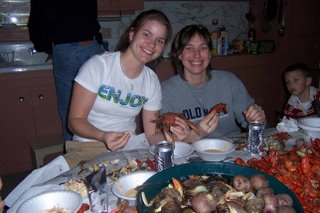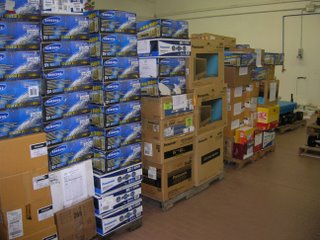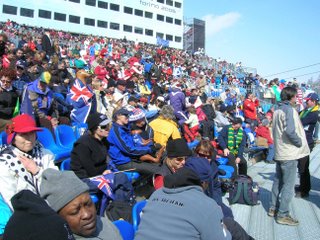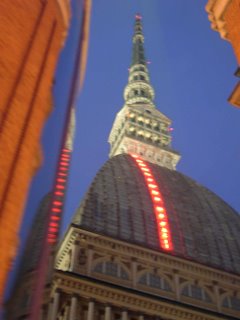In typical Karen travel fashion, I decided a couple of days before jumping on a train that I wanted to take a cooking class in a smaller, hill-side Italian city. Robyn was a good sport in this spontaneous travel planning and trusted that things would work out. And man, did it work out! I called the number on the UmbriaCooks4U website to see if they would give a class for only 2 people and on only 2 days notice. I was a little worried that communication would be a problem when a very Italian voice answered the phone “
Pronto.”. . . "Um, do you speak English?" Instantly, the voice changes to the Bronx-laden English of Nonie, half owner of this cooking experience endeavor. "
Only 2 people? And day after tomorrow?
Let me check with the chef, but I think it’ll be OK." A couple of phone calls later, we’re all set. On the train to Perugia, Robyn asks what we’ll be cooking. “You know- typical Umbrian food” I answer kind of vaguely. In other words, I have no idea!
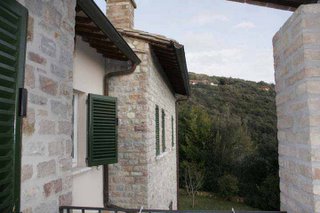
Nonie calls us the night before to make sure we know where she’ll pick us up. Perugia is full of one-way streets and no-traffic, pedestrian throughways, so she makes us do a run through so we can call her ahead of time if we have any problems. The next day, she picks us up in her yellow Panda (not the yellow Honda we were looking for) and whisks us away to Tita’s hillside home surrounded by olive trees (we used olive oil from these trees during our cooking) and one of the biggest Rosemary bushes I’ve ever seen! It was winter and she was having some work done to the outside of the house and wasn’t happy that we would see her home that way. The house and the view were unbelievable, renovations and everything.
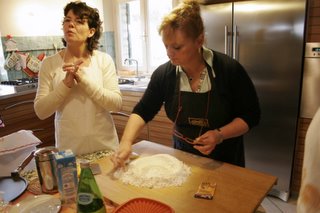
So, before I launch into the play-by-play of our cooking class, let me give you some background on Nonie and Tita’s friendship. Nonie, a native New Yorker, came to Perugia in the 70s to study Italian language (Aunt Ruth, I could totally see you in her stories!). In the process she met her future husband and became fast friends with Tita. Although Nonie went back to the States for a few years to finish school, she’s basically lived, and raised her family, in Perugia ever since. Tita is the chef and didn’t speak much English (though I think she understood every word said!) and Nonie is the interpreter/story-teller/dishwasher. The duration and depth of their friendship throughout love, life, and kids is apparent and deepens the whole cooking experience.

I guess I should tell yall what we cooked, huh?
Antipasti (Hors d'oeuvre)Torta al Testo con Proscuitto Nostrale(Flat bread with Umbrian ham)
Torta al Testo con Stracchino e rucola(Flat bread with soft cheese and rucola)
Bruschette al Pecorino con olive all' orancia fatte in casa(Sheeps' milk cheese bruschetta and olives seasoned with orange peels)
Cestino di Parmigiano alle Pere(Parmesan cheese baskets with pears)
Primi (First Course)Pasta e Ceci Tiepida(Chickpea soup with pasta)
Carbonara di Zucchini(Egg sauce with zucchini [over tortollini])
Secondi (Meat)Straccetti all' alloro(Veal strips with laural [bayleaf]
Fagiolini in forma(Baked stringbeans [in Béchamel sauce])
Dolci (Dessert)Torini Fondenti al Cioccolato(Melting chocolate mold)
Gelato(Tita's yummy homemade icecream!)
Frutta di stagione(Seasonal fruits)
Vino (Wine)Vini rossi e bianchi tipici DOC Umri(Red and white Umbrian DOC wines)
Vino Passito(Sweet wine)
Caffe' (Coffee)(Espresso)
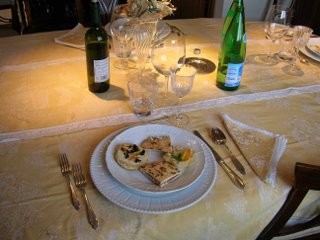
So, we set out looking for an authentic Italian cooking experience and that’s exactly what we got. We cooked in Tita’s home kitchen. It was definitely a chef’s kitchen, but not an industrial one. Her son was home from school and taking a nap while we were cooking and came out later to see what we were cooking and to chat for a bit. At the end of dinner, Tita’s husband came home from work and contributed to the lively table discussion. By the end of the whole experience, we had Tita and Nonie showing us photos from when they first became friends and some of the family vacations they’ve taken together over the years. We got more than an authentic Umbrian cooking class, we got two wonderful, talented women opening their homes and lives to us in a way that made us feel more like friends than cooking students. I can honestly say - this day was the highlight of my stay in Italy.
 My last day in Louisiana, the weather smiled upon our family bar-b-que. It was still a bit chilly in the shade, but the sun was shining bright without a cloud in the sky (as my sunburnt nose will attest to!). A few family and friends stopped by to hang out for the afternoon. Most of the family pictures are on my mom's camera, so I don't have any good ones of the fam to post.
My last day in Louisiana, the weather smiled upon our family bar-b-que. It was still a bit chilly in the shade, but the sun was shining bright without a cloud in the sky (as my sunburnt nose will attest to!). A few family and friends stopped by to hang out for the afternoon. Most of the family pictures are on my mom's camera, so I don't have any good ones of the fam to post. It was hard to leave the warmth of my family and bayous to come back to my land-locked, cold Colorado home. I know my Northern friends will think I'm just being a wuss when I call this cold, but as I'm typing this, the outside temp is in the mid-30s!
It was hard to leave the warmth of my family and bayous to come back to my land-locked, cold Colorado home. I know my Northern friends will think I'm just being a wuss when I call this cold, but as I'm typing this, the outside temp is in the mid-30s!
